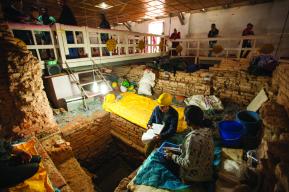Under the battering winds of the Roaring Forties and the Furious Fifties, scientists from the TAAF and the IPEV collected samples in the biodiversity-rich and turbulent waters bordering the Kerguelen Archipelago. The islands of the archipelago are one of the three districts of the French Southern Territories National Nature Reserve, which is part of the French Austral Lands and Sea site that was inscribed on the UNESCO World Heritage List in 2019.
The group of scientists first collected in Swains Bay – an area accessible exclusively via a five-hour hike and 315 meter climb up the Devil’s Volcano, which offers a panoramic view of the fjords. Welcomed by curious elephant seals, the young biologists proceeded to take water samples from the shoreline. Located just outside of the Gulf of Morbihan, Swains Bay is connected to the Southern Ocean and serves as an important nursery and feeding area for many marine species.
The second sample site, Haute Island in the Gulf of Morbihan, was reached by boarding the L'Aventure II, the flagship of the Port-aux-Français fleet that transports scientists to their work sites throughout the Gulf. The presence of Commerson's dolphins (Cephalorhynchus commersonii), an endemic subspecies of Kerguelen, during the sampling, as well as the sighting of a southern right whale (Eubalaena australis) give a first indication of the richness of the marine biodiversity present around the island.
Environmental DNA is a methodology used to identify species according to the DNA they shed in their environment. With its status as a national nature reserve, scientific operations within the French Austral Lands and Seas must be as non-intrusive and low impact for the environment as possible. eDNA is therefore a valuable scientific method, since it allows the monitoring of biodiversity through a simple water sample, without the need to extract organisms from their environment.
Combined with data obtained from acoustic listening devices, eDNA analysis could perhaps be used to confirm the presence of many cetacean species which regularly visit the coastal waters of the Kerguelen Archipelago. Scientists also hope that the collected eDNA samples will confirm the presence of more discrete cetacean species and other marine species that are rare or difficult to observe in the vast marine protected area.
In a context of global change from which the Southern Ocean is not exempt, the still intact environments of the French Austral Lands and Seas are real observatories of life. The eDNA method is a valuable tool for monitoring the state of conservation of marine biodiversity and detecting the presence of invasive alien species, about which we have little information at this stage.
The unique geological and oceanographic setting of the French Austral Lands and Seas has enabled the development of rich and diverse marine ecosystems. The coastal environments embrace a great diversity of habitats and species, providing essential functional areas for both birds and marine mammals. The islands are surrounded by a wide belt of Durvilleae algae, followed by dense stands of giant kelp (Macrosystis pyrifera), which play an important ecological role as shelter, nurseries, and breeding grounds for a large part of the marine fauna. The southern seas are consequently frequented by numerous species of cetaceans, some of which are regularly observed within the World Heritage site, including Commerson's dolphins and killer whales (Orcinus orca).
The UNESCO eDNA initiative is a joint collaboration between the Intergovernmental Oceanographic Commission and the World Heritage Centre. It is made possible with the support of the Government of Flanders (Kingdom of Belgium) and implemented in the context of the United Nations Decade of Ocean Science for Sustainable Development (2021-2030).
About the French Austral Lands and Seas World Heritage site
The French Austral Lands and Seas comprise the largest of the rare emerged landmasses in the southern Indian Ocean, including the Crozet Archipelago, the Kerguelen Islands, Saint-Paul and Amsterdam Islands, as well as 60 small sub-Antarctic islands. This ‘oasis’ in the middle of the Southern Ocean covers an area of more than 672 000 km2 and supports the largest population of King Penguins and Yellow-nosed Albatrosses in the world. The remoteness of these islands from centres of human activity makes them extremely well-preserved showcases of biological evolution and a unique terrain for scientific research.





